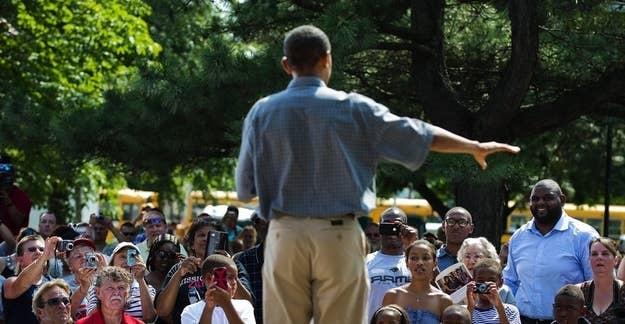
PARMA, Ohio — President Barack Obama’s first bus tour of the campaign is shaping up to be more like a Senate candidate’s swing though Ohio — save for the massive media contingent.
Obama attracted just 520 people to his first event in Maumee today, just outside of the auto-industry town of Toledo. A second stop on the southern shore of Lake Erie in Sandusky brought out an even smaller cadre of supporters — just 350 according to the local fire marshal.
Here in Parma, Obama spoke on a tiny portion of a massive sports field complex just miles from heavily-Democratic Cleveland to a crown the fire marshal put at 1,000 — and reporters put at substantially less.
While attendance isn’t a clear indication of support — Obama still leads in the state by more than two points in the RealClearPolitics poll of polls — it does signal where the Obama campaign’s priorities are.
Where in 2008, each Obama rally was a collective, ecstatic experience for thousands of supporters frustrated by the Bush years, Obama 2012 is a more disciplined media-centric operation — finely honed to attract just the crowd needed to provide the perfect backdrop for the evening news and the morning papers.
Obama senior adviser David Axelrod credited the "intimacy" of the events for the president's ability to speak off the cuff — often reacting to the audience.
"The intimacy of this, the value of that, is that it is kind of a setting that he can do what he’s done — which is...have a nice talk about what this is all about and to do it in a very personal way," he said after Obama's remarks, noting that the local news coverage was the real winner for the campaign. "It was set up that way, and I feel its been really good."
The smaller crowds also lessen the chances of hecklers or Romney operatives will sneak into the event, as they have in the past by obtaining general admission tickets.
Obama used his remarks to highlight his support for the state’s auto-industry and to defend his health care law.
"I'll work with anybody who wants to work with me to continue to improve our health care system and our health care laws, but the law I passed is here to stay," Obama said in Maumee.
Two bus-loads of national reporters followed Obama across the state, with dozens of local reporters following along at each stop.
The Obama campaign chose small, picturesque locations for both events — a historical museum and a town square complete with gazebo — but while the crowds were packed tightly around the podium, there was room for many hundreds more supporters at each site.
The Obama campaign has tended toward smaller venues since they couldn’t fill the arena for their kickoff rally at a Columbus arena two months ago, leaving thousands of empty seats. The tighter, more controlled venues feature carefully placed barricades to keep supporters in the camera shot at all times — making the space appear far smaller than it truly is.
The Republican Party and the Romney campaign deployed two potential vice presidential candidates — Louisiana Gov. Bobby Jindal and former Minnesota Gov. Tim Pawlenty — on their own bus tour across Ohio. According to the campaign, they turned out had 225 supporters in Parma, and 150 supporters in Niles.
The massive venues of four years ago are gone for now. Obama’s so-called “framing-speech” in Cleveland last month drew about 1,500 supporters — the maximum the location could fit. A similar speech in New Hampshire last week was even smaller — 1,200 were in the gym while 750 were sent to an overflow room because the campaign handed out extra tickets to ensure they filled the space. Both events were in Democratic strongholds, but the campaign chose not to risk securing a larger venue.
According to a campaign spokesman all of the bus tour stops are open to the public — though only a limited number of tickets were distributed. The spokesman said there were lines more than an hour before tickets were distributed at some locations.
